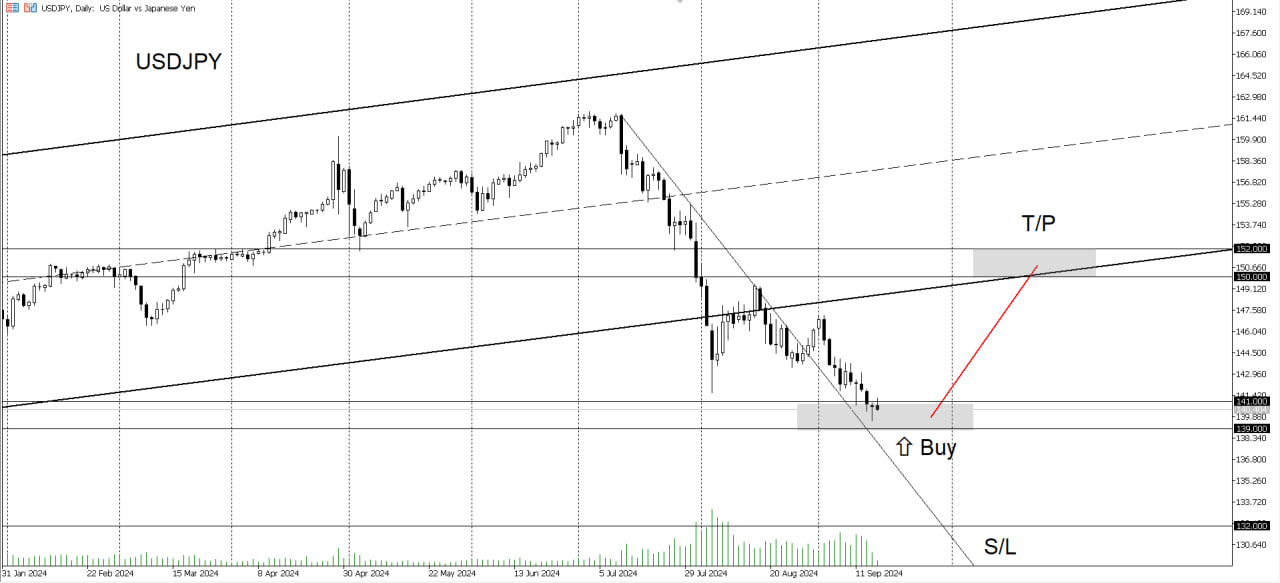- Metadoro
- Markets
- Currencies
- USDJPY - US Dollar to Japanese Yen
USDJPY USD/JPY
US Dollar to Japanese Yen
US Dollar to Japanese Yen
- By date
- Metadoro first
The USDJPY has been on a notable decline, falling by 4.4% so far in September after experiencing a 2.4% drop in August. This downtrend has brought the pair to its lowest levels since July 2023. Historically, USDJPY has tended to rise in September, making this year's performance an anomaly. However, the pair has recently broken through the resistance of its downtrend, which could signal a potential for recovery.
From a technical perspective, the ideal zone for opening long trades is around the 139.000-141.000 range, where a strong support level lies. If this support holds, the pair could potentially rebound toward an upside target of 150.000-152.000, representing a possible gain of 7.0-8.0%.

US Dollar to Japanese Yen
- The Yen is a safe haven asset during economic turbulence or raging political risks. It is a desired shelter during Banking or energy crisis, stock market crashes, etc. During such periods, the currency receives additional growth drivers. In this case USD/JPY, EUR/JPY, GBP/GPY are pushed down. Such downside movements are usually very strong if accompanied by negative news;
- During positive market sentiment and rising risk appetite, the demand for the Yen is lower and USD/JPY rises;
- As a safe-haven asset, the Yen’s movements are tracked via risk tolerance indicators. The USD/JPY is very sensitive to the change of S&P 500 broad market index. The pair has a negative correlation to the index. The pair has a positive correlation with the CBOE Volatility Index, simply known as the VIX Index. The latter could serve as an indication of the likely direction of the USD/JPY;
- The Yen is one of the most popular currencies for carry trade. This is a process of borrowing at low interest rates, which are one the lowest in Japan, and investing in assets with higher rates of return;
- The Yen is heavily dependent on the Bank of Japan’s (BoJ) actions. Japan is an export-driven country, and a weaker Yen is vital for the country to get export advantages. So, the BoJ is prone to a weaker Yen and tries to avoid unnecessary strengthening of the currency even during strong demand for it. The BoJ is also known for its unexpected market interventions, when it throws large Yen liquidity in the market to dump the Yen exchange rate;
- The BoJ is also known as a protagonist of ultra-low or even negative interest rates and an ultra-loose monetary policy. It keeps the policy stable for decades to stimulate domestic economic growth. Such a monetary stance supports the weakness of the Yen. However, it may change at some point after the new BoJ governor steps in. Although the new governor is seen to be prone to continuing the ultra-loose monetary policy, his rhetoric and the BoJ’s actions should be carefully monitored;
- Currency pairs with the Yen, like USD/JPY, are volatile mostly during night hours for Europe, or during the Asian trading session hours.
| Ticker | USDJPY USD/JPY |
| Contract value | 100000 USD |
| Maximum leverage | 1:500 |
| Date | Short Swap (pips) | Long Swap (pips) | No data |
|---|
| Minimum transaction volume | 0.01 lot |
| Maximum transaction volume | 100 lots |
| Hedging margin | 50% |
| USD Exposure | Max Leverage Applied | Floating Margin |
|---|









